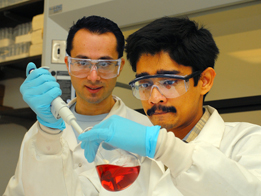Home > Press > UCF Technique Promises to Aid Doctors' Ability to Identify, Treat Bacterial Infections
 |
| Photo: Jacque Brund.
Nanoscience Technology Center post-doctoral fellow Sudip Nath and graduate student Charalambos Kaittanis are co-authors of the study published in Analytical Chemistry. |
Abstract:
A new technique developed by a University of Central Florida chemist will help physicians more quickly identify the bacterial infections patients have so they can be treated in hours instead of days.
UCF Technique Promises to Aid Doctors' Ability to Identify, Treat Bacterial Infections
Orlando, FL | Posted on February 20th, 2008As more bacterial strains resistant to many drugs emerge, it becomes more critical to quickly identify infections and the antibiotics that would most effectively treat them. Such quick identifications become even more important during epidemics because large numbers of samples would have to be tested at once.
Assistant Professor J. Manuel Perez's new technique also promises to give research institutes and pharmaceutical companies a quicker and cheaper way of developing new antibiotics to combat super bugs.
The results of Perez's study were recently published online in Analytical Chemistry (pubs.acs.org/cgi-bin/asap.cgi/ancham/asap/pdf/ac701969u.pdf). The research was funded in part by the National Institutes of Health.
"The method really gives doctors quicker access to test results so they can treat their patients more quickly," Perez said from his lab at the Nanoscience Technology Center at UCF. "But there are more applications. This method can also be used by research facilities and big pharmaceutical companies for the high throughput screening of drugs for antibacterial activity."
Perez uses gold nanoparticles coated with a sugar and a protein that binds to sugars. Meanwhile, a variety of antibiotics are placed in the same solution. A spectrophotometer reads optical variations in the gold nanoparticle solution as the sugar and protein shift , which in turn demonstrate which antibiotics effectively halt bacteria growth and which ones do not. Results can be obtained within a couple of hours, in contrast to the traditional methods, which can take days to complete. And hundreds of samples can be tested at once using this technique because the amount of bacteria and antibiotic needed is small.
Pharmaceutical companies can use existing equipment to read the variations, which means they do not have to buy new equipment. Perez's study also shows that the technique is as sensitive and accurate as the traditional, more time-consuming approach.
"We're very excited and very pleased with the results," Perez said.
The research was completed with the help of the UCF Chemistry Department and the Burnett School of Biomedical Sciences. Nanoscience Technology Center post-doctoral fellow Sudip Nath and graduate student Charalambos Kaittanis are co-authors of the study, as is Alisa Tinkham, formerly of the Burnett School.
####
About University of Central Florida
UCF Stands for Opportunity -- Established in 1963, the University of Central Florida is a diverse metropolitan research university that ranks as the 6th-largest in the country with more than 48,000 students. Located in Orlando, Fla., UCF offers high-quality undergraduate and graduate education, student development, and continuing education, while conducting cutting-edge research that powers the region’s economic development. For more UCF news, visit news.ucf.edu.
For more information, please click here
Contacts:
Zenaida Gonzalez Kotala
News and Information
407-823-6120
Copyright © University of Central Florida
If you have a comment, please Contact us.Issuers of news releases, not 7th Wave, Inc. or Nanotechnology Now, are solely responsible for the accuracy of the content.
| Related News Press |
News and information
![]() Researchers develop molecular qubits that communicate at telecom frequencies October 3rd, 2025
Researchers develop molecular qubits that communicate at telecom frequencies October 3rd, 2025
![]() Next-generation quantum communication October 3rd, 2025
Next-generation quantum communication October 3rd, 2025
![]() "Nanoreactor" cage uses visible light for catalytic and ultra-selective cross-cycloadditions October 3rd, 2025
"Nanoreactor" cage uses visible light for catalytic and ultra-selective cross-cycloadditions October 3rd, 2025
Nanomedicine
![]() New molecular technology targets tumors and simultaneously silences two ‘undruggable’ cancer genes August 8th, 2025
New molecular technology targets tumors and simultaneously silences two ‘undruggable’ cancer genes August 8th, 2025
![]() New imaging approach transforms study of bacterial biofilms August 8th, 2025
New imaging approach transforms study of bacterial biofilms August 8th, 2025
![]() Cambridge chemists discover simple way to build bigger molecules – one carbon at a time June 6th, 2025
Cambridge chemists discover simple way to build bigger molecules – one carbon at a time June 6th, 2025
![]() Electrifying results shed light on graphene foam as a potential material for lab grown cartilage June 6th, 2025
Electrifying results shed light on graphene foam as a potential material for lab grown cartilage June 6th, 2025
Discoveries
![]() Researchers develop molecular qubits that communicate at telecom frequencies October 3rd, 2025
Researchers develop molecular qubits that communicate at telecom frequencies October 3rd, 2025
![]() Next-generation quantum communication October 3rd, 2025
Next-generation quantum communication October 3rd, 2025
![]() "Nanoreactor" cage uses visible light for catalytic and ultra-selective cross-cycloadditions October 3rd, 2025
"Nanoreactor" cage uses visible light for catalytic and ultra-selective cross-cycloadditions October 3rd, 2025
Announcements
![]() Rice membrane extracts lithium from brines with greater speed, less waste October 3rd, 2025
Rice membrane extracts lithium from brines with greater speed, less waste October 3rd, 2025
![]() Researchers develop molecular qubits that communicate at telecom frequencies October 3rd, 2025
Researchers develop molecular qubits that communicate at telecom frequencies October 3rd, 2025
![]() Next-generation quantum communication October 3rd, 2025
Next-generation quantum communication October 3rd, 2025
![]() "Nanoreactor" cage uses visible light for catalytic and ultra-selective cross-cycloadditions October 3rd, 2025
"Nanoreactor" cage uses visible light for catalytic and ultra-selective cross-cycloadditions October 3rd, 2025
|
|
||
|
|
||
| The latest news from around the world, FREE | ||
|
|
||
|
|
||
| Premium Products | ||
|
|
||
|
Only the news you want to read!
Learn More |
||
|
|
||
|
Full-service, expert consulting
Learn More |
||
|
|
||








